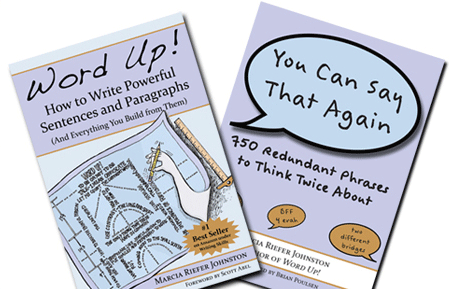Go to the A-Z page | Get the book: Word Up!
clause
A group of related words containing a subject and a verb. Clauses come in two types: independent and dependent (subordinate).
Compare phrase.
comma-spliced sentence
A run-on sentence that includes two independent clauses joined by only a comma, making the comma a “comma splice”: Max bent down to pick up the rock, he heard his back snap.
Compare fused sentence.
For more, see the chapter “Running On about Run-Ons” in Word Up!
complex sentence
A sentence that contains exactly one independent clause and at least one dependent clause: Although the snow blower’s lack of cooperation frustrated him, Xavier persisted until he got the thing running again. A complex sentence distinguishes the subordinate ideas (Xavier’s frustration) from the more important ones (Xavier’s persistence).
Compare simple sentence, compound sentence, compound-complex sentence.
compound-complex sentence (complex-compound sentence)
A sentence that contains two or more independent clauses and at least one dependent clause: Although the snow blower’s lack of cooperation frustrated him, Xavier persisted until he got the thing running again, and the neighbors cheered.
Compare simple sentence, compound sentence, complex sentence.
compound modifier (adjectival compound, phrasal adjective, unit modifier)
A phrase that functions as a unit in modifying a noun. When a compound modifier precedes the noun, it requires a hyphen—with rare (and hotly disputed) exceptions. In snow-crusted chronicles, the phrase snow-crusted is a compound modifier, acting as an adjective that describes, oddly if mellifluously, the noun chronicles.
For more, see the chapters “Hyphens Unite!” and “To Hyphenate or Not To Hyphenate After a Noun: That Is the Wrong Question” in Word Up!
compound sentence
A sentence that contains two or more independent clauses: Xavier’s snow blower conked out, and he had a devil of a time getting it to run again.
Compare simple sentence, complex sentence, compound-complex sentence.
conjunction
A structure-class word that joins words, phrases, or clauses. Conjunctions come in various types, including coordinating conjunctions, subordinating conjunctions, and conjunctive adverbs.
For more, see the chapter “A Modern Take (Is Take a Noun?) on Parts of Speech” in Word Up!
conjunctive adverb
An adverb that acts as a conjunction: therefore, nevertheless, however, subsequently, otherwise, then. Conjunctive adverbs join two independent clauses, signaling a relationship between them: cause and effect, sequence, contrast, comparison, etc.
In Siobhan shoveled as fast as she could; nevertheless, night fell before she could finish the job, the word nevertheless acts as a conjunctive adverb, revealing a contrast between Siobhan’s speed and the sun’s. A conjunctive adverb is followed by a comma and preceded by a semicolon—or a period: Siobhan shoveled as fast as she could. Nevertheless, night fell.
(The words identified here as conjunctive adverbs may also play other roles, in which case they are classified differently.)
Compare coordinating conjunction and subordinating conjunction.
For more, see the chapter “A Modern Take (Is Take a Noun?) on Parts of Speech” in Word Up!
consonance
A type of alliteration in which consonant sounds are repeated, as in Tuckered-out and thirsty, Titus can’t feel his toes. Here the consonance consists of seven t sounds. (Only the sounds count; the ear doesn’t care about spelling.) The New York Times crossword puzzle often includes consonant clues, like Parmesan pronoun (answer: “mio,” Italian for my).
For more, see the chapter “Your Words Come Alive with a Hint of Music” in Word Up!
content words
See form-class words.
coordinating conjunction (coordinator)
A conjunction that joins words, phrases, or clauses of equal grammatical rank or function (coordinate words, phrases, or clauses). Coordinating conjunctions have no characteristic features of form. You can remember the most common ones by the acronym FANBOYS: for, and, nor, but, or, yet, so.
In Hey, fanboy, how about a bowl of chili or a mug of wassail? the coordinating conjunction is or. A bowl of chili and a mug of wassail are coordinate phrases.
In Jacqueline drove through the storm to get chili powder, and Jacques stayed home to cook, the coordinating conjunction is and, and the two independent clauses are the coordinate elements. When the coordinate elements are independent clauses, the conjunction is preceded by a comma.
As for the notion that sentences shouldn’t start with and or but, forget it—lest you fall for a “rank superstition” and a “gross canard.”[1] Kicking off with and or but is, in fact, “highly desirable in any number of contexts.” Good writers do it all the time, especially in informal writing. But they don’t follow either little word with a comma.
(The words identified here as coordinating conjunctions may also play other roles, in which case they are classified differently.)
Compare conjunctive adverb and subordinating conjunction.
For more, see the chapter “A Modern Take (Is Take a Noun?) on Parts of Speech” in Word Up!
copular verb
See linking verb.
This is not a list of all words about writing—you’d be scrolling all day. These definitions evolved while I was writing Word Up! I enjoyed what I learned and wanted to share it.
Get the full glossary and more in the book: Word Up! How to Write Powerful Sentences and Paragraphs (And Everything You Build from Them)
—
[1] Bryan A. Garner, Garner’s Modern American Usage, 3rd ed. (Oxford: Oxford University Press, 2009), 44 under “and,” 121 under “but.”


